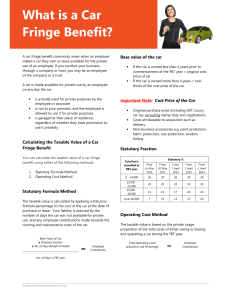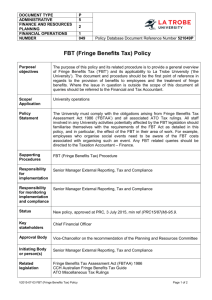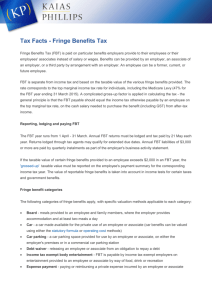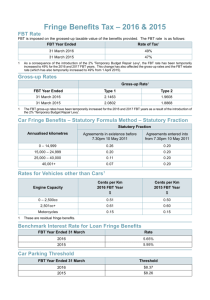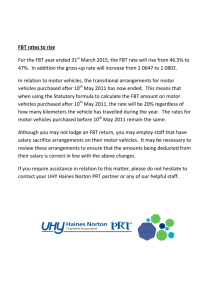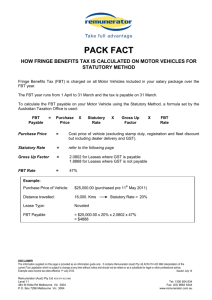Fringe Benefits Tax on Car Benefits
advertisement
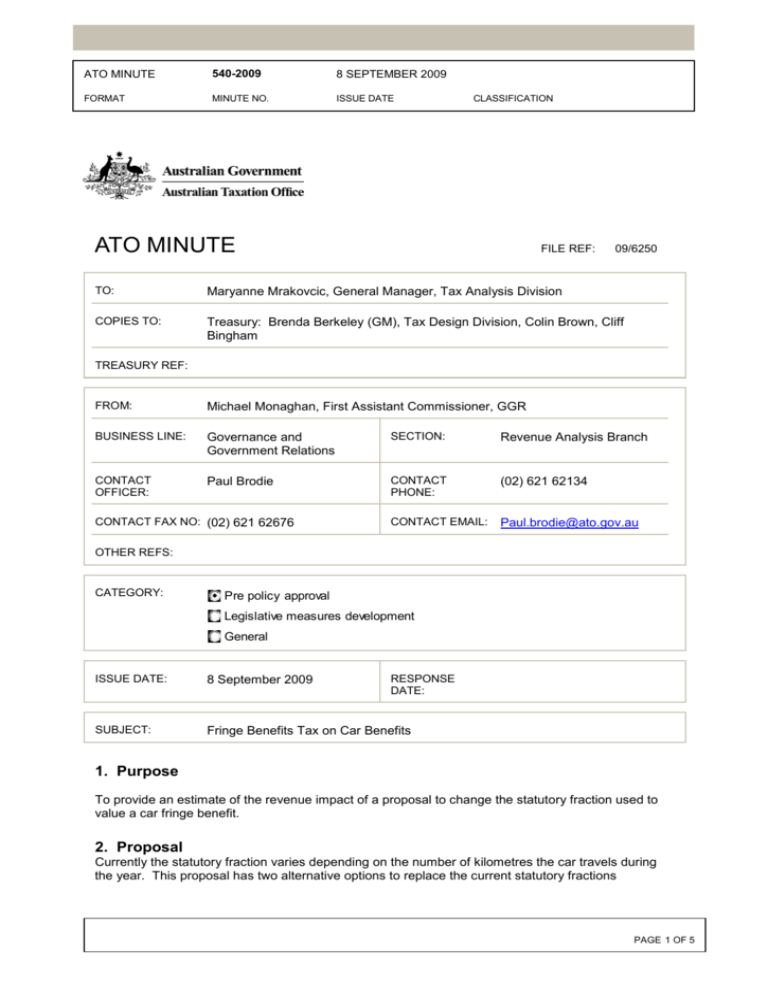
ATO MINUTE 540-2009 8 SEPTEMBER 2009 FORMAT MINUTE NO. ISSUE DATE CLASSIFICATION ATO MINUTE FILE REF: 09/6250 TO: Maryanne Mrakovcic, General Manager, Tax Analysis Division COPIES TO: Treasury: Brenda Berkeley (GM), Tax Design Division, Colin Brown, Cliff Bingham TREASURY REF: FROM: Michael Monaghan, First Assistant Commissioner, GGR BUSINESS LINE: Governance and Government Relations SECTION: Revenue Analysis Branch CONTACT OFFICER: Paul Brodie CONTACT PHONE: (02) 621 62134 CONTACT EMAIL: Paul.brodie@ato.gov.au CONTACT FAX NO: (02) 621 62676 OTHER REFS: CATEGORY: Pre policy approval Legislative measures development General ISSUE DATE: 8 September 2009 RESPONSE DATE: SUBJECT: Fringe Benefits Tax on Car Benefits 1. Purpose To provide an estimate of the revenue impact of a proposal to change the statutory fraction used to value a car fringe benefit. 2. Proposal Currently the statutory fraction varies depending on the number of kilometres the car travels during the year. This proposal has two alternative options to replace the current statutory fractions PAGE 1 OF 5 FBT AND CARS Option A: introduce a flat statutory fraction of 0.20 with the following transitional arrangements FBT Year 2010-11 2011-12 2012-13 2013-14 1 – 15,000 0.20 0.20 0.20 0.20 Distance Travelled (kms) 15,000 – 25,000 25,000 – 40,000 0.20 0.14 0.20 0.17 0.20 0.20 0.20 0.20 40,000 + 0.10 0.13 0.17 0.20 Option B: introduce a flat statutory fraction of 0.15 with the following transitional arrangements FBT Year 2010-11 2011-12 2012-13 2013-14 1 – 15,000 0.15 0.15 0.15 0.15 Distance Travelled (kms) 15,000 – 25,000 25,000 – 40,000 0.15 0.12 0.15 0.13 0.15 0.14 0.15 0.15 40,000 + 0.09 0.11 0.13 0.15 The new statutory fractions will only apply to new leases. The existing fractions will continue to apply to arrangements entered into before 1 April 2010. 3. Start Date 1 April 2010 4. Background One method for valuing a car fringe benefit is the statutory formula method. Under this method, the taxable value of the car fringe benefit is a percentage of the car’s cost price and is calculated using the following formula: (A x B x C ) – E D Where: A = the base value of the car B = the statutory percentage C = the number of days in the FBT year when the car was used or available for private use of employees D = the number of days in the FBT year E = the employee contribution The greater the total distance the car travels (business and private), the lower the taxable value. The statutory percentage depends on the total kilometres the car travels, as follows: Total kilometres travelled during the FBT year Statutory percentage Less than 15,000 26 15,000 to 24,999 20 25,000 to 40,000 11 Over 40,000 7 5. Impact analysis – summary details 5.1 Revenue impact – (see Appendix 1) PAGE 2 OF 5 FBT AND CARS The revenue impact has been estimated using different behavioural responses. Option A Flat 0.20 statutory fraction Financial Year Revenue Impact 2010-11 2011-12 2012-13 2013-14 $m $m $m $m 125 383 723 968 2010-11 2011-12 2012-13 2013-14 $m $m $m $m 38 524 501 682 Option B Flat 0.15 statutory fraction Financial Year Revenue Impact 5.2 Compliance cost impact Not requested 5.3 Departmental impact Not requested Michael Monaghan First Assistant Commissioner Governance and Government Relations PAGE 3 OF 5 FBT AND CARS Appendix 1 – Revenue impact Option 1 – Statutory formula method - flat 0.20 statutory rate (phased-in, new contracts only) PLUS 0c/ km - 1 Apr 10 start date Salary Sacrifice FBT Company Personal Income Tax GST 2010-11 -38 0 152 21 2011-12 -76 0 406 54 2012-13 -84 0 686 91 2013-14 -92 0 900 119 Total -291 0 2,144 284 Employer Provided FBT Company Personal Income Tax GST 2010-11 -23 0 14 0 2011-12 -39 0 38 0 2012-13 -28 -7 64 1 2013-14 -22 -23 84 2 Total -112 -30 201 3 Option 1 - Total Revenue Impact Underlying Cash Balance 2010-11 125 104 2011-12 383 329 2012-13 723 632 2013-14 968 847 Total 2,199 1,912 Salary Sacrifice FBT Company Personal Income Tax GST 2010-11 -48 0 133 17 2011-12 34 0 356 45 2012-13 38 0 600 75 2013-14 89 0 788 99 Total 112 0 1,876 236 Employer Provided FBT Company Personal Income Tax GST 2010-11 -73 0 9 0 2011-12 64 0 25 0 2012-13 -268 13 43 0 2013-14 -306 -43 56 0 Total -583 -30 134 0 Option 1 - Total Revenue Impact Underlying Cash Balance 2010-11 38 21 2011-12 524 479 2012-13 501 426 2013-14 682 584 Total 1,746 1,510 Option 2 Statutory formula method - flat 0.15 20 statutory rate rate (phased-in, new contracts only) PLUS 0c/ km - 1 Apr 10 start date Reliability of estimate This estimate is of low to medium reliability. It is highly sensitive to the number of cars the statutory fraction distribution and the behavioural response effects. Data FBT return 2008-09 Individual tax return 2006-07 The impact of Australia’s Fringe Benefits Tax for cars on petrol consumption and greenhouse emissions by D Kraal, P Senarath Yapa and D Harvey PAGE 4 OF 5 FBT AND CARS Assumptions The distance travelled by cars is distributed in the following proportions: Annual km thresholds 0-15 15-25 25-40 Proportion of vehicles in range (as % of total using SFM) 14.1% 25.5% 40.8% >40 19.6% Average car price of $34,323 Acquisition price of 90.9% of car price (to exclude GST) The cash out value is equal to the operating costs of the car 34.38% marginal tax rate for individuals that cash out Fuel costs of 0.20 cents per kilometre 5.85% deemed interest rate 18.75% depreciation rate 91.7% of pay as you go withholding collected within year 0% of company collection collected within year. 45% of cars are salary sacrificed, the remainder are employer provided cars The proportion of cars using the grandfathered statutory rates over time are Proportion of current affected by new FBT 2010-11 80.0% 2011-12 50.0% 2012-13 20.0% 2013-14 0.0% Option A All cars which currently travel up to 25,000 kilometres per year continue to receive a car fringe benefit Eighty percent of individuals who have a salary sacrificed car fringe benefits where over 25,000 kilometres per year are travelled will opt out Thirty percent of individuals who have an employer provided car fringe benefits where over 25,000 kilometres per year are travelled will opt out Where an employee opts out their total remuneration package will only increase where the car was an employer provided fringe benefit. Option B All cars which currently travel up to 25,000 kilometres per year continue to receive a car fringe benefit Seventy percent of individuals who have a salary sacrificed car fringe benefits where over 25,000 kilometres per year are travelled will opt out Twenty percent of individuals who have an employer provided car fringe benefits where over 25,000 kilometres per year are travelled will opt out Where an employee opts out their total remuneration package will only increase where the car was an employer provided fringe benefit. Methodology Estimated FBT collections for car fringe benefits where the statutory formula method is used were calculated for the 2010/11 budget year onwards. where FBT collections = (car price X acquisition price adjustment X statutory fraction – employee contributions) X number of cars X type 1 gross up rate X FBT rate FBT collections for these years under the proposed statutory fractions were then calculated after taking into account the behavioural response by individuals who choose to cash out their benefit for extra salary, the transitional statutory fractions and the rate of new lease acquisition. The resultant impact on pay as you go withholding, company and GST collections were also estimated. The impact on revenue is the difference between current FBT collections and the overall impact on revenue from the proposed statutory fractions. PAGE 5 OF 5
